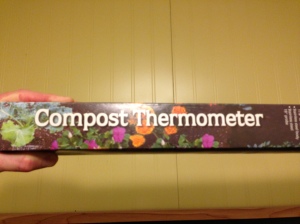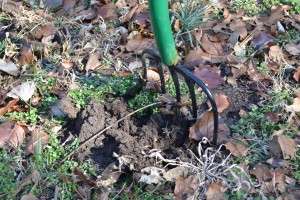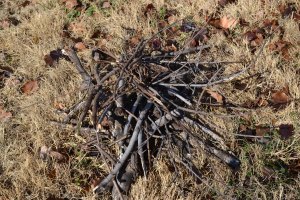Compost Update
Posted: January 15, 2013 Filed under: farm | Tags: Composting, Farming, Sustainability Leave a comment
Today I purchased a fun new garden tool… drumroll please… A Compost Thermometer! This purchase, however, was bitter sweet, for I have discovered an issue that needs to be remedied quickly. I walked out to my compost pile and plopped that sucker down to the middle of the heap. The reading was a measly 60° F. Sigh. So I am regrouping and assessing where I may have gone wrong.
There could be a number of reasons for the absence of thermal energy in my organic mass of goodness. Is it not getting enough moisture? Could be a factor in drought-stricken Oklahoma, but we actually got quite a lot of rain in the weeks following its formation. Is it the carbon to nitrogen ratio? Possibly, a higher carbon to nitrogen ratio results in lower temperatures. Also, it is January, and the air temperature has been around 30° F for several days now, which according to the University of Illinois Extension can slow or even stop the decomposition process. The goal is to have a significant amount of aerobic bacteria in your pile – they aid in the process of decomposition and release heat as they work. The heat is important because it kills disease-causing organisms and weed seeds that you don’t want to appear with your crops.
I’m pretty sure air flow is not an issue, it seems pretty porous and the layers will provide for some nice air pockets. From what I have read it appears the first course of action is to turn the pile and add some more nitrogen materials. Luckily I have some food waste and coffee grounds stored up which may do the trick. Thankfully, there is no odor, so it may just be slow getting started and been adversely effected by the cool temps. Hopefully I start seeing some action soon. My plan is to water, check and track the temperature often, and keep turning while trying to balance out and find the ideal carbon:nitrogen mix.
Check in for future updates to see how it progresses!
Zach
Not Italian Food
Posted: January 4, 2013 Filed under: farm | Tags: Biointensive, Composting, Farming, Gardening Leave a commentI got to play in the dirt for the first time in a while yesterday. I started a beautiful decomposing mass of organic matter, the compost pile. It’s the cornerstone of a healthy garden, providing a nutrient-dense medium for plant growth. A good farmer knows you need great soil to have great crops. So here is how I did it. I know there is a seemingly endless amount of variations, ingredients, and otherwise, but I went with what I had available and tried to stick closely to the biointensive method, though I haven’t had the opportunity to grow crops specifically for composting. The video below is a quick slide show of the lasagna-style stacking process.
 First, I found a nice spot and mapped out about a 4’x4′ border. The square is important because it allows for an even gravitational force to be exerted on the entire pile, as opposed to the heavy center and light sides that result from a rounded pile. I broke up the soil using the manure fork, pushing about 12″ deep and creating sufficient pockets for air flow. I didn’t worry about the weeds, I guess I’ll see how that turns out in a month or so.
First, I found a nice spot and mapped out about a 4’x4′ border. The square is important because it allows for an even gravitational force to be exerted on the entire pile, as opposed to the heavy center and light sides that result from a rounded pile. I broke up the soil using the manure fork, pushing about 12″ deep and creating sufficient pockets for air flow. I didn’t worry about the weeds, I guess I’ll see how that turns out in a month or so.
Next, I put a base layer of dried sticks, again to encourage air flow. Each step after that was pretty simple. I alternated layers of brown, or carbon-rich materials with layers of green, more nitrogen heavy material. I used dried leaves for the carbon layers, they are about a 40:1 carbon:nitrogen ratio. A good ratio for the pile is about 30:1, so I had to balance that with some nitrogen layers. For the green, it varied a little, I used grass clippings, food waste, coffee grounds, and some pea plants I pulled up the other day. On top of each green layer I added a sprinkling of soil to encourage some good microbial action. As the pile grew, I added stakes on the four corners to help ensure it stayed square, and watered to keep the pile moist (which is why it appears to shrink near the end of the video).
Overall it was a pretty simple process. I will be adding a few more in the coming week because I still have a lot of leaves and clippings to work with and I’m collecting food waste and coffee grounds from any willing donors. I will need to keep it watered consistently and monitor the temperature at the center of the pile, which will ideally exceed 100 degrees F soon! In a month or two I will check in on the pile, flip it and make sure any material that is not decomposed makes it to the center of the pile, though this one may take significantly longer due to the cold temps and shorter periods of sunlight.
Grow Happy,
Zach
